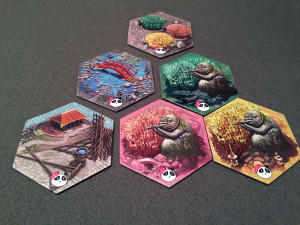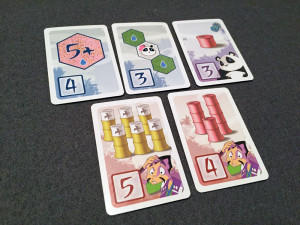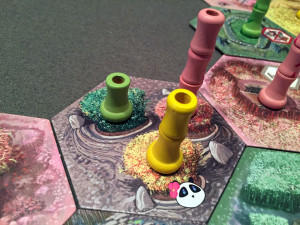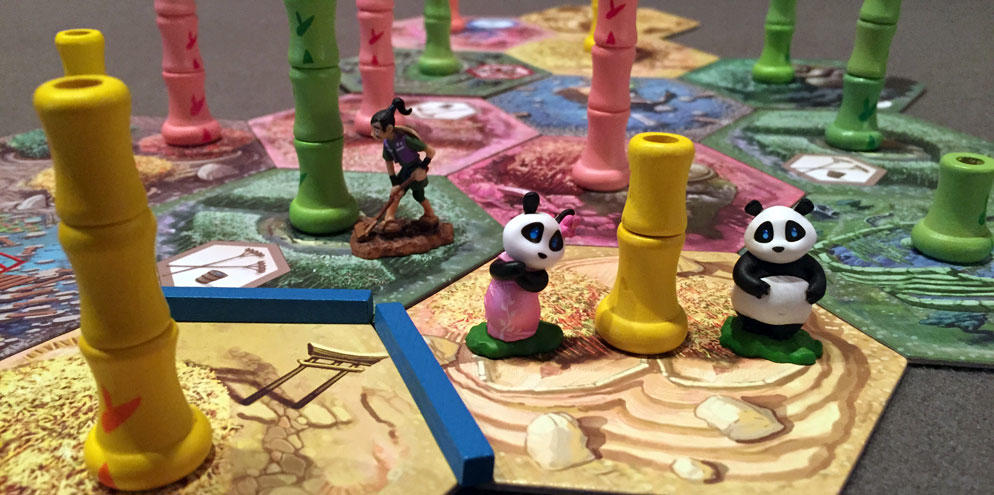 Back in 2013 we reviewed a fantastic game called Takenoko. This cleverly designed tile laying game sucked us in with its simple mechanics and stunning visuals and components. We had few criticism of this gem and it has made its way to our gaming table countless times.
Back in 2013 we reviewed a fantastic game called Takenoko. This cleverly designed tile laying game sucked us in with its simple mechanics and stunning visuals and components. We had few criticism of this gem and it has made its way to our gaming table countless times.
Recently, game designers Antoine Bauza (7 Wonders, Hanabi) and Corentin Lebrat (Open Sesame) jumped back into the bamboo garden and gave us a new expansion. Takenoko: Chibis gives our lonely panda some company, and also new areas to explore. Today we are going dive in to the Chibis expansion and see if it can improve upon an already great game.
Expansion Overview:
Takenoko: Chibis adds a couple of new things to the base game and I’ll go over the different parts in turn. In addition to what I’m about to cover, the expansion also provides some additional wooden bamboo pieces which are identical to their base game counterparts.
Mrs. Panda
Players now have a female panda to join the bamboo consuming bear from the base game. With her also comes 9 baby panda tokens. During the game, when you move a panda, you can choose instead to move the female panda (however she doesn’t eat bamboo). If she ends up on the same tile as the male panda, they can have a baby. Discard a matching color bamboo piece and take a baby token. This will provide you with 2 victory points and one of three possible bonuses: An irrigation token, an improvement token, or the ability to trade in an objective card.
6 New Plot Tiles

These are unique tiles that all have a special property.
Celestial Pond: This acts in all respects to the starting pond, however it’s drawn and placed during the game like the rest of the tiles.
Kamis Garden: This tile grows all 3 bamboo types and acts as a wild for completing plot objective cards.
Sacred Hills: One in each of the three colors, when the gardener ends his movement on one of these tiles, it grows bamboo on all matching color tiles (not just adjacent ones)
Gardener’s Cabin: When the gardener ends his movement here, you can draw one of each objective card and keep one.
New Objective Cards

There are a few new plot cards of each type. These ratchet up the complexity from the base game a bit as well. For example: The panda cards require you to discard the appropriate color bamboo as usual, but the panda must first be sitting on a pond tile. There are also some plot ones that require an expansion tile to be between two other colored tiles or to have 6+ of one color plots to be irrigated in the plantation. There are 5 new types of objectives in all (2 plot, 2 gardener, 1 panda).
There are also 2 new game play variants in the rule book. The first states that a panda cannot eat the base shoots, only the upper 3 segments. The second states that players are awarded 3 bonus VPs for each set of completed objective cards they have (a set being one of each type).
Game Experience with the Expansion:
One of the nice things about Takenoko is how easy it is to teach new players. This is a game I could play with just about anyone. I’ve introduced it to my gamer friends and also family members. Almost universally, players have no issues picking up the rules and all seem to love the components. So one thing I was curious about was how much complexity this expansion adds. As you know, one of my hallmarks for a great expansion is when it can easily integrate with the base game. I don’t ever want to feel like I’m learning a second game when I get an expansion.

And on that note, the designers definitely succeeded as it was incredibly easy to learn the ins-and-outs of Takenoko: Chibis. I was able to mix in the new components and jump right in to play. Even better is that I don’t have to spend time separating components out when I’m done. That’s because playing with the expansion was so easy (and fun), I don’t ever see a reason to play without it in the future.
Of the six new plot tiles, I must say, I love all of them. They really do feel unique from the base game and add in some new strategic options. The three Sacred Hills tiles are fantastic for getting a certain color of bamboo to grow. I found myself sending the gardener there often to help me complete objectives. However the Kamis Garden is probably my favorite tile. The fact that it grows all three bamboo and counts as all three colors for objective cards makes it a really powerful tile. It was used quite often in our games.
Other than the new tiles, the real difference comes with the female panda and her babies. This added a welcome new action to the game that helped give the game a bit more diversity. In the past, it has been really easy to spam the panda objective cards (more on that later) as those always seemed to be the easiest to complete. The chibis tokens provides a tempting alternative use for the bamboo pieces you’ve collected. Now not only do you get a bonus item/action, but you also gain 2 vps. The baby token that provides an irrigation token was a nice touch because I always found that to be the least interesting action in the game.

The baby token that lets you swap out an objective card can also be really useful. Sometimes you get stuck with a card in your hand you know you will never complete. For example, in one of our games, no one seemed to be playing the yellow bamboo tiles. I think the 3rd one made it’s way to the board about three quarters of the way into the game. So the player with the “have 6+ yellow tiles on the board” used the chibis token to swap out that objective card. Before the expansion, there wasn’t a way to get rid of an unwanted objective cards and players would be stuck with them.
One thing I didn’t mention was the components. Depending on what edition of the base game you have, there may be some slight, matching issues. The backs of the new tiles are a slightly different shade than the base tiles. I was concerned at first, but quickly found that it didn’t affect the game play at all. Since you are drawing three tiles, knowing where the top tile of the stack comes from doesn’t really alter the game play at all. But for those of you who are super anal about these things, be forewarned.
Finally, lets talk about the variant rules that come with the game. We had already been playing with the one from the base game that forces you to re-draw an objective card if it was already completed when drawn. That helped minimize some of the luck in the game. These new variant rules both help solve the issue of players focusing on Panda objectives.
As mentioned above, in the past, it was way to easy to just concentrate on completing panda objectives. The new rule that gives 3 points for having a full set of complete objectives really altered the way we were approaching the game. Almost all players were now trying to acquire the sets to get the bonus points. 3 points might not seem like a lot, but most of our games are pretty tight and two sets can definitely make a difference.

Final Thoughts:
For fans of Takenoko, the Chibis expansion should be a no-brainer. If you weren’t a fan of the Takenoko, there possibly might be enough here to change your mind. But it would very much depend on what your objections were. While the game play really didn’t change all that much, Takenoko: Chibis does add a nice layer of strategy that wasn’t present in the base game. Panda objective cards are no longer the obvious path to victory (especially with the variant rules) and the chibi tokens help players adjust to keep their strategies flexible.
If you are a fan of Takenoko, then consider the Takenoko:Chibis to be a required expansion. Its’s so easy to integrate that I don’t see myself ever playing without it again. Even new players should really have no issues using Chibis on their first play. The only new rule is with the female/baby pandas, and those are easily enough explained. Some games don’t really need an expansion even though one was made (Istanbul comes to mind), but Takenoko: Chibis is a great expansion that makes a good game even better. Check this one out today.
If you’d like to pick up a copy of Takenoko: Chibis, you can get it for about $25.
 Hits:
Hits:
• Easy to integrate into your game
• Adds variety without increasing complexity
• Helps encourage players not to only take the panda objectives
Misses:
• Some component matching issues
























Love this expansion
Jesus, Mary and Joseph, why does Female Panda have to wear a pink dress and have a slimmer waist?! Was that the only way the could think of to differentiate the game piece from the default male panda. Grrmff.
Calm down karen 😉